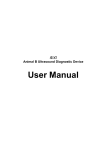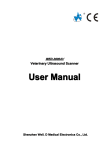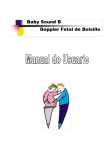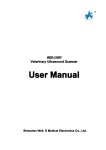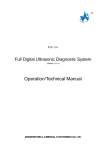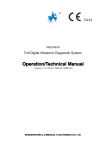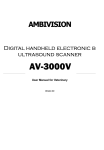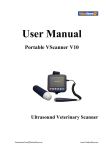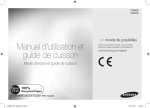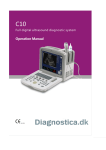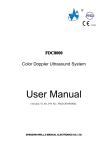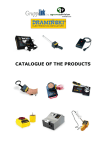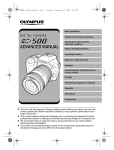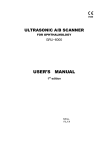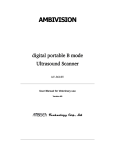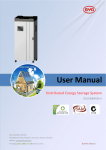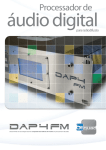Download 第四章 操作流程
Transcript
WED-3000V Veterinary Ultrasound Scanner User Manual SHENZHEN WELL.D MEDICAL ELECTRONICS CO. LTD. Preface ........................................................................................................................................................... 1 Statement ................................................................................................................................................. 1 Manufacturer's warranty .......................................................................................................................... 1 Matters need Attention ............................................................................................................................ 2 Safety labels ............................................................................................................................................ 2 General tips for equipment operation ...................................................................................................... 3 General Safety Message .......................................................................................................................... 3 1 Summary .................................................................................................................................................... 6 1.1 Brief Introduction .............................................................................................................................. 6 1.2 Range of application.......................................................................................................................... 6 1.3 Appearance ........................................................................................................................................ 7 1.4 Technical Specificatio ....................................................................................................................... 7 1.5 Electric principle block diagram ....................................................................................................... 8 1.6 Standard configurations ..................................................................................................................... 9 1.7 Optional pieces .................................................................................................................................. 9 2 Installation ................................................................................................................................................ 10 2.1 Operation environmental requirements ........................................................................................... 10 2.2 Installing and disassembling battery ............................................................................................... 10 2.3 Installing and disassembling probes ................................................................................................ 11 2.4 Power Supply .................................................................................................................................. 12 2.4.1 Power supply with adapter .............................................................................................. 12 2.4.2 Battery Operation.............................................................................................................. 12 2.5 Battery charging .............................................................................................................................. 13 2.5.1 Charging through main unit ............................................................................................. 13 2.5.2 Charging through adaptive line....................................................................................... 13 2.5.3 Charging through auto-charger ...................................................................................... 14 3 Operating procedures ............................................................................................................................. 15 3.1 Introduction of keyboard ................................................................................................................. 15 3.2 Display interface ............................................................................................................................. 16 3.3 Operating procedures ...................................................................................................................... 16 4 Image parameter adjustment................................................................................................................. 17 4.1 Display mode switching .................................................................................................................. 17 4.2 Image freezing ................................................................................................................................. 18 4.3 Gain adjustment............................................................................................................................... 18 4.4 Image brightness adjustment ........................................................................................................... 18 4.5 Image smoothing ............................................................................................................................. 18 4.6 Gray correction ................................................................................................................................ 18 4.7 Dynamic range adjustment .............................................................................................................. 19 4.8 Depth adjustment............................................................................................................................. 19 4.9 Scanning angel adjustment .............................................................................................................. 19 4.10 Focus adjustment ........................................................................................................................... 20 4.11 probe work frequency .................................................................................................................... 20 4.12 Frame-related adjustment .............................................................................................................. 21 4.13 M rate adjustment .......................................................................................................................... 21 4.14 Screen cleaning ............................................................................................................................. 21 4.15 Restore factory settings ................................................................................................................. 21 -I- 5 Image processing .................................................................................................................................... 22 5.1 Overview ......................................................................................................................................... 22 5.2 Cine loop ......................................................................................................................................... 22 5.3 Static image storage (SAVE) ........................................................................................................... 23 5.4 Image export (SVLOAD) ................................................................................................................ 23 5.5 ZOOM ............................................................................................................................................. 24 5.6 Upside down.................................................................................................................................... 24 5.7 Turning around ................................................................................................................................ 24 5.8 Pseudo color procedure ................................................................................................................... 25 5.9 Bar chart .......................................................................................................................................... 25 5.10 Image cleaning .............................................................................................................................. 25 5.11 Report ............................................................................................................................................ 26 6 Explanation............................................................................................................................................... 27 6.1 Overview ......................................................................................................................................... 27 6.2 Type the basic information of the patient and hospital .................................................................... 27 6.3 Image explanation ........................................................................................................................... 28 6.4 date and clock adjustment ............................................................................................................... 29 6.5 Language switching......................................................................................................................... 29 6.6 Body mark ....................................................................................................................................... 29 7 Measurement ........................................................................................................................................... 31 7.1 Ordinary measurement .................................................................................................................... 31 7.1.1 Distance measurement .................................................................................................... 31 7.1.2 perimeter/area measurement ......................................................................................... 31 7.1.3 Volume measurement ...................................................................................................... 33 7.1.4 M mode measurement ..................................................................................................... 33 7.2 Obstetrics measurement .................................................................................................................. 33 8 Check and Maintenance ........................................................................................................................ 41 8.1 Service life....................................................................................................................................... 41 8.2 Main unit maintenance .................................................................................................................... 41 8.3 Probe maintenance .......................................................................................................................... 42 8.4 Correct usage of probe .................................................................................................................... 43 8.5 Battery information ......................................................................................................................... 43 9 Simple Trouble Shooting ........................................................................................................................ 45 9.1 Check............................................................................................................................................... 45 9.2 Simple trouble shooting................................................................................................................... 45 10 Transportation and Storage ................................................................................................................. 46 10.1 Environment requirements on transportation and storage ............................................................. 46 10.2 Transportation................................................................................................................................ 46 10.3 Storage........................................................................................................................................... 46 Appendix A Acoustic output reporting table ............................................................................................ 47 Appendix B Obstetrics ............................................................................................................................... 51 - II - Preface Statement This publication, including pictures and illustrations, is property of Shenzhen Well.D Medical Electronics Co., Ltd. and under protection of international copyright law. Information in this document is not annotated to change. The manufacture shall not state nor observe any warranty basing on this point, and definitely give up any implied warranty basing on any special purpose of selling or making benefit. Without previous written permission from the producer, this document must not be photocopied, reproduced or translated into other languages. We preserve the right of revision on this document without still further notice. Some pictures in this manual, which are schematic diagrams for indication only, may disaccord with the real object, and then the real object should be regarded as the final. is trade marks of Shenzhen Well.D Medical Electronics Co., Ltd. Any abuse of these trade marks without permission will be sued to assume legal responsibility according to laws. Manufacturer's warranty Shenzhen Well.D Medical Electronics Co., Ltd. assumes the responsibility for equipment security, reliability and performance only under the preconditions that the disassembly, assembly and maintenance of the equipment are all performed by its assigned professional and the equipment is used strictly in compliance with the operation manual. Shenzhen Well.D Medical Electronics Co., Ltd. ensures a guarantee period within a year and a half since the delivery day and promises there is no problem with the new equipment in material and technology. Within the guarantee period, Shenzhen Well.D Medical Electronics Co., Ltd. will maintain the equipment and replace the parts of non-man-made damages free of charge. But will not repair or replace the equipment surface if it is damaged. This guarantee is only available for failures occurred when the equipment is operated in compliance with the operation manual. And the guaranteed equipment can only be used in the prescribed range given in manual. This guarantee excludes losses or damages caused by external reasons such as thunder struck, earthquake, theft, unsuitable use or abuse and refitting the equipment. Shenzhen Well.D Medical Electronics Co., Ltd. shall not be responsible for damages caused by other devices or arbitrary connection to other devices. -1- Shenzhen Well.D Medical Electronics Co., Ltd. shall not be responsible for losses, damages or injuries caused by delayed service request. When there is problem with the products, please contact Shenzhen Well.D Medical Electronics Co., Ltd. and explain the equipment model, serial number, date of purchase and the problem. Matters need Attention To ensure operational safety and long-term stable equipment performance, please read this operation manual closely and understand the equipment functions, operation and maintenance at all points before operating the equipment, especially contents of "Warning", "Caution" and "Note". Maloperation or inobservance of the instructions given by manufacturer or its agents may result in equipment damage or personal injury. The following convention works through this manual to lay special emphasis on some information. "Warning": Stands for neglect of it will cause severe personal injury, death or realized property loss. "Caution": Stands for neglect of it will cause slight personal injury or property damage. "Note": to remind user of installation, operation or maintenance information. These information is very significant but with no risk. Any warning against dangers shall not be contained in NOTE. Safety labels Equipment labels explanation: Note! Refer to accompanying documents Signal output USB2.0 IPX7 Protection against dripping water ClassⅡequipment Mouse Probe socket Packing and transportation labels explanation: -2- Handle carefully Temperature limit Upward Piling layer limit Keep dry Protect against heat General tips for equipment operation Note: The equipment is use only for veterinary. ◆ In operation 1. Heat radiation holes are strictly prohibited to be covered. 2. After closedown, do not switch on the equipment within 2 - 3 minutes. 3. On scanning, if any abnormal case is found, stop scanning immediately and shut down the equipment. 4. The patient is prohibited to touch any non-applied part of the equipment. 5. When operating, do not press the keyboard panel too much, otherwise the equipment might be damaged. ◆ After operation 1. Power off the equipment. 2. Pull out the plug from power supply socket instead of pulling the cable. 3. Clean off the couplant on the probe with soft medical sterilized cotton ball. 4. Put the probe into the special case. General Safety Message Safety of the operator and patients and reliability of the equipment are taken into consideration during designing and producing, the following safety precaution must be implemented: -3- 1. The equipment shall be operated by qualified operating staff or under their instructions. 2. Do not open the equipment and change the parameters without permission. If necessary, please turn to for Shenzhen Well.D Medical Electronics Co., Ltd. or its authorized agent for service. 3. The equipment has already been regulated into its optimal performance. Do not adjust any preset control or switch unless operate as per instructions in the manual. 4. If there is equipment failure, please shut down the equipment at once and contact for Shenzhen Well.D Medical Electronics Co., Ltd. or their authorized agent. 5. If it is needed to connect the equipment with other company’s' electronic or mechanical devices , please contact Shenzhen Well. D Medical Electronics Co,. Ltd. before connection. 6. Equipment operation, storage and transportation environment Environmental requirements on normal operation: a) Environment temperature range: 0℃~ +40℃ b) Relative humidity range: ≤80% c) Atmosphere pressure range: 70KPa~ 106Kpa Environment requirements on equipment storage and transportation: a) Environment temperature range: -20℃~+55℃ b) Relative humidity range: <80%(20℃) 7. Do not hit the fragile TFT-LCD display. If it cracks, deal carefully with it in case the liquid crystal gets into eyes or mouths. 8. Must not hit the inner chargeable Li-ion battery nor throw it into fire in case it trigger an explosion;Do not short circuit the battery output electrodes in case the battery be damaged; and please use the original binding charger to charge the battery. More over, because used battery will cause environment pollution, please handle the battery correctly for recovery processing. 9. Must not disassemble the power supply adapter. If failures happen, it should be handled by the professional; the charging output can only be used for charging the battery of the equipment, any improper use on other battery may cause explosion, fire and other unexpected hazards. 10. Must not short circuit the output of the adapter,a long term short circuit shall result in adapter damage. 11. Please use standard power cord as the input line of the network power supply for the -4- adapter to reduce risk. 12. Shenzhen Well.D Medical Electronics Co., Ltd. shall not take any responsibility for any risk resulted from unauthorized re-fitment by the users. 13. To disconnect the equipment from the power supply network by unplug the adapter from the power supply network. 14. Refer to appendix B for sound output parameters. Warning: When working in an intensive electromagnetic environment beyond its pre-stated one, WED-3000V's image may be interfered thus influence the diagnose. At this time, stop the device and reuse it until the electromagnetic interference is removed. Warning: When WED-3000V works with other devices in reduplication or in close parallel, unforeseen EMC problem may appear. If they have to work closely, observe all the devices and verify if they are influenced by unexpected EM coupling. -5- 1 Summary 1.1 Brief Introduction This equipment is high resolution linear/convex Veterinary Ultrasound Scanner. It adopts micro-computer control and digital scan converter (DSC), digital beam-forming (DBF), real time dynamic aperture (RDA), real time dynamic receiving apodization, real time Dynamic receiving focusing (DRF), Digital frequency Scan (DFS), frame correlation technologies to endue its image with clarity, stability and high resolution. There are five display modes: B, B+B, B+M, M and 4B; And 256 gray scale. The system can process real time image display, freeze, save, load, up and down flip, left and right flip, capacity cine loop; Multi-level scanning depth, dynamic range, Scan angle, frame correlation factor regulation and focus number, focus position, etc. Date, clock display; name, sex, age, hospital annotation; Distance, circumference, area, volume and heart rate measurement; EDD Measurement for equine, bovine, sheep, dog and cat. It offers 16 body marks. And Multiple-choice probes for the clinic diagnosis demands. Video output offers connection to external video image printer and large-screen display and other equipments. High speed USB port provides real time image transfer to the PC. Combined power supply mode of AC adapter and built-in chargeable battery, 3 battery charging modes and the low power consumption and advanced power management technology promise more lasting battery operation. 7 inches TFT-LCD display and field programmable gate array (FPGA) and surface mounted technology (SMT) make this equipment compact and light in weight. Jet molding enclosure with hand-held structure. The equipment consists of main unit, probe and adapter. 1.2 Range of application Suitable for diagnosis on horses, cows, sheep, pigs, cats and dogs and other animals. -6- 1.3 Appearance Front sketch Side interfaces sketch Top knobs sketch 1.4 Technical Specificatio WED-3000V MODEL L1-5/7.5MHz HF linear LV2-4/6.5MHz Rectal Probe Detect Depth(mm) Hz convex ≥80 ≥140 C1-12/20R/5.0M Hz micro-convex 35LV150CP Backfat probe ≥90 ≥160 ≤3 (Depth≤ 60) ≤2 (Depth≤ 80) ≤1 (Depth≤ 60) ≤1 (Depth≤ 80) Lateral ≤1 (Depth≤ 60) Axial ≤1 (Depth≤ 80) ≤3 (Depth≤ 80) ≤5 (80< Depth≤130) ≤1 (Depth≤ 80) ≤3 ≤6 ≤5 ≤5 ≤5 ≤7.5 ≤7.5 ≤5 ≤5 ≤5 ≤5 ≤5 Resolution (mm) Blind zone(mm) Geometric position precision C1-11/50R/3.5M Horizont al Vertical -7- Monitor size 7 Inch TFT LCD Display mode B、B+B、4B、B+M、M Image gray scale 256 Scale Image storage 64 Frame Dynamic range 0-192dB(Adjustment range 64-192dB) Cine loop ≥340 Frame Scan depth 70mm~240mm Image flip Up/down, left/right Focus Focus Number, Focus position Body mark 16 Image Process Pseudo color, GAMA, Image Smoothen, Histogram Probe Frequency Adjustable(3 point each probe) Angle Show, Adjustable Measure Distance, Circumference, area, volume, Gestational age, expected date Output report Date, clock, name, PID, age, Sex, hospital name, doctor, full-screen character editor Support Interface 2*USB2.0,VIDEO,MOUSE Battery Continuous work ≥3Hours Size L(265mm)*W(46mm)*H(153mm) Net weight 800g Power 45W Character display 1.5 Electric principle block diagram -8- 1.6 Standard configurations Main unit power adapter Battery 35LV150CP Backfat probe Adapter power supply cord Coupling gel 250ml Manual Final examination report Packing List 1.7 Optional pieces LV2-4/6.5MHz Rectal probe C1-11/50R/3.5MHz convex array probe C1-12/20R/5.0MHz micro convex probe L1-5/7.5MHz HF linear probe Printer CD High speed USB cable Warning: Please use the spare parts specified above. The manufacturer shall not bear the responsibility of safety problem, unexpected EMC performance drop caused by arbitrary adoption of non-specified spare parts. -9- 2 Installation 2.1 Operation environmental requirements Environment temperature range: 0℃~+40℃ Relative humidity range: ≤80% Atmosphere pressure range: 70KPa~106Kpa Power supply: a.c.100V~240V,50Hz±1Hz/60Hz±1Hz Avoid strenuous vibration during operation; Keep away from equipments with high electric field, high magnetic field and high voltage; avoid strong sunlight on the display; Keep the equipment well-ventilated, damp proof and dustproof. Note: Check according to the "packing list" after uncasing and make sure that there is no shipping damage, and then install the equipment according to requirements and methods described in “Installation”. Warning: If there is breakage at unpacking check, it is banned to use the device to ensure security. The probe should be protected from felling off or crashing and the manufacturer. 2.2 Installing and disassembling battery Install battery: Set the battery into the battery slot and move the battery release key on its side to top till the battery is inserted completely and then release the key (refer to figure). Disassemble battery: It is the reverse process of installation (refer to figure). - 10 - 2.3 Installing and disassembling probes Install probes: The probe jack lies in the bottom of the right side of the equipment. Adjust the probe plug mark position and insert it, turn the plug lock sleeve counter-clockwise. There is only one plug jack which is also compatible for those optional probes (refer to figure). 1 2 3 Disassemble probes: It is the reverse process of installation. Warning: Installation and disassembly of the probe must comply with the operation instructions, must not twiddle the sheath around the plug (refer to figure). Warning: Do not by all means unplug or plug the probe connector at state of log on in case the probe and main unit be damaged. - 11 - 2000 times of efficient connection and disconnection of the probes are guaranteed.Once the probe is connected with the main unit, do not unplug nor plug it at discretion in case poor contact happen. Warning: The probe should be protected from felling off or crashing and the manufacturer assumes no responsibility for the kind of hazard. Warning: Must not touch the contact pin in the probe connector. Warning: Please handle the equipment carefully. 2.4 Power Supply The equipment provides two automatic switch-over modes to supply power: adapter and built-in battery. 2.4.1 Power supply with adapter 1. Check the input power cord plug of the adapter to see if it matches the EPS outlet. 2. Check the EPS to see if it is in the specified range and the power cord to see if it is connected well. 3. Check the adaptor to see if it works well: Plug the power cord into the AC input outlet, switch on the power switch of the outlet, if the DC output indicating light turns on green, it works well. 4. Shut the power switch of the outlet. 5. Insert the DC output plug of the adapter into the DC14V/3A outlet in the rear of the equipment, switch on the outlet. 6. Press the power switch, the main unit is power on and the power indicator light turns on, that means the adapter operate well. 2.4.2 Battery Operation 1. Install the battery correctly on the main unit. 2. Switch on the power switch on the left side of the equipment. When the main unit is power on, the power indicator will turn on. 3. The equipment can start operation. Note: At power off state, there is still certain power consumption with the main unit. If the main unit can not be turned on when pressing down the switch, that is to say the battery is running up and needs charging. Note: When the main unit charging/volume indicator light is flashing, that is the battery is running up and it should be charged as soon as possible. - 12 - Warning: It is prohibited to use any other power supply except the standard adapter as the external power supply for the main unit. 2.5 Battery charging There are 3 ways to charge the battery. 2.5.1 Charging through main unit 1. Install the battery correctly into the main unit. 2. Insert the plug of “ ” of the adapter into the “DC14V/3A” interface on the rear. 3. Connect power cord of “ ”of the adapter to the AC. EPS. 4. Whenever the main unit is power on or off, the “Charging/Volume” indicator light turns on, it means the battery is charged through adapter; when the lights turn on, it means the battery is fully charged(refer to figure). Charging through main unit Tip: To prolong the battery operation time, please finish charging when the indicator lights show that the battery is full. 2.5.2 Charging through adaptive line 1. Take out the battery from the main unit or take out the spare battery. 2. Connect the round end of the adaptive line to the " " terminal of the adapter, and the flat end to the charging terminal of the battery. 3. Connect power cord of " " of the adapter to the AC EPS. - 13 - 4. When the " " " indicator light on the adapter turns into red, the battery is in charging; when the " indicator light turns into green, the battery is fully charged. (Refer to figure). Charging through adaptive line 2.5.3 Charging through auto-charger 1. 2. 3. 4. Take out the battery from the main unit or take out the spare battery. Connect the flat end marked with an arrow of the auto-charger to the charging terminal of the battery. Plug the other end of the auto-charger into the cigar lighter socket. When the "Charging" indicator light on the adapter turns into red, the battery is in charging; when the "Charging" indicator light turns into green, the battery is fully charged. (Refer to figure). Charging through auto-charger Tips: The input voltage of the auto-charger is DC9~14V/1.5A. The output voltage of the auto-charger is DC12.6V/1A. The operations and storage environment are the same as those of the main unit. - 14 - 3 Operating procedures 3.1 Introduction of keyboard Power indicator Display area Power switch Freezes button Probe socket Function button Mouse As a supplement of computer operation, mouse can make the measurement faster and more convenient. PC mouse of which the left button, middle button and right button have specific functions is applied to the equipment. Left button Freeze the image or display the measuring mark. Middle button End the measurement and display the result of volume measurement. Right button ● Determine the start and end position of the cursor, and switch the start cursor and end cursor in the distance measurement mode. ● Determine the start position of the cursor and complete the measurement of perimeters and areas in the free arm type measurement of perimeters and areas. ● Be equal to the role of button in the elliptical type measurement of perimeters and areas. Note: "FUNC / 3" reserved function keys for the device. - 15 - 3.2 Display interface Hospital name Patient name Patient age Patient gender System date, time Probe frequency Doctor name Focous, focal distance Current scanning angle Scanning direction mark probe type Medical record number overall gain Frame correlation value Brightness, image smoothing, grey correction Near field, far field gray scale band Dynamic range, frame frequency Probe raster Battery capacity indicator Status indicator of cineloop Depth display 3.3 Operating procedures 1. Switch on the power button“ 2. Press any button to enter the B-type ultrasonic scan interface. 3. Type the basic information of the patient. Press “ 4. ”. ” to type the information including name, PID, age, gender, hospital, doctor. Spread ultrasonic coupling agent on the probe acoustic shadow surface, and close to the scanning area, then the real-time image can be observed on the screen. 5. Freeze the image, and conduct measurement on the image. 6. Create a report, print the report and image by the connected video printer. - 16 - 4 Image parameter adjustment 4.1 Display mode switching B mode switching Press “B/0”button in the real-time scanning mode to switch current image to real-time single B mode. (The default mode when the equipment is power on) BB mode switching Press “BB/1” button to switch the current image to double B mode. Real-time image and freeze image are displayed on the screen. Press “BB”button continuously to switch the real-time and freeze states of two images. (Attention: Backfat probe does not support) B+M/M mode switching Press “BM/2” button to switch the current image to B+M mode. B type and M type real-time images can be displayed on the screen at the same time. The sample line of B type image can be moved around by mouse and arrow button. Press this button again to switch the current image to M mode, and then an M type image is displayed on the screen. (Attention: Backfat probe does not support) 4B mode switching Press “FUNC/3”to switch the current image to 4B mode in the B type, BB type real-time scanning mode. Four B type images are displayed, one of which is in a real-time state. Press“FUNC/3”button continuously to switch the real-time and freeze states of four images. (Attention: Backfat probe does not support) B M BB B+M 4B Attention: When you call up the menu, please exit the menu before switching the display mode. - 17 - 4.2 Image freezing Press “ ”button to switch real-time state and freeze state. “FROZEN” on the bottom of screen is the freeze mark. Freeze key 4.3 Gain adjustment Press 7 or 8 button in real-time state to active gain, near field and far field on top right of the screen. Then press ▲5 and ▼6 button to adjust gain value. The gain adjustment range is 0-62, and the near field and far field adjustment range is 0-30. The pre-set gain value is 27. Press to exit. 4.4 Image brightness adjustment Press 7 or 8 button in real-time state to lighten “B” on top right of the screen, then press ▲5 and ▼6 button to adjust the brightness. Press to exit. 4.5 Image smoothing Press 7 or 8 button in real-time state to active this function. The “IM” on the right of screen is lightening. Then press ▲5 and ▼6 button to adjust sharpen level, there are three levels can be chosen, which listed as IM0, IM1, IM2. Press to exit. Common image Image after smoothing 4.6 Gray correction Press 7 or 8 button in real-time state to active this function. The “GY” on the right of screen is - 18 - lightening. Then press ▲5 and ▼6 button to adjust the gray scale of image. The adjustment range is GY0-GY7. Press to exit. Tip: When an external monitor is applied, the image might be properly displayed only by gray scale correction. 4.7 Dynamic range adjustment Press 7 or 8 button in real-time state to active this function. The “DR” on the right of screen is lightening. Then press ▲5 and ▼6 button to adjust the dynamic range. The dynamic range is 0-192dB, and the adjustment range is 64-192dB. Press to exit. 4.8 Depth adjustment Press to exit the parameter adjustment state on the right of screen. Press ▲5 and ▼6 button in the B type real-time mode to switch the current scanning depth. The current depth is displayed on the bottom right of screen. The depth adjustment range changes with different probe type. The following table is presented as a reference. Probe type depth (mm) C1-11/50R/3.5 MHz L1-5/7.5MHz C1-12/20R/5.0 MHz LV2-4/6.5MHz 35LV150CP 90~240 40~90 80~150 65~140 70~170 Depth 90 Depth 180 Depth 240 4.9 Scanning angel adjustment Press 7 or 8 button in real-time state to active this function. The “Angel” on the right of screen is lightening. Then press ▲5 and ▼6 button to switch the scanning angel. When mentioning probe angel, please refer to the following table. - 19 - Press to exit. Probe type C1-11/50R/3.5MHz C1-12/20R/5.0MHz angle 70º visual and adjustable 96º visual and adjustable 4.10 Focus adjustment Focus number Press 7 or 8 button in real-time B mode or BB mode state to light “Focus” on the top right of screen, and then press “+/9”button repeatedly to switch the focal point number to one or two. Meanwhile, the current focal point number is displayed on the right of screen, such as “focus: 2 D3”, “D3” means that the focal distance is 3 cm. Press to exit. Attention: When the focus is set to 2, the current image frame frequency would be reduced. Focal position Press 7 or 8 button in real-time B mode or BB mode state to light “focus” on the top right of screen, and then press ▲5 and ▼6 button to move the focus up and down, and change the focal position. Press “ ”→“B/0”in turn to exit. Tip: The focusing of image near the focus indicator is better, and you can change the focus number and focal position, so that the focus will point to the interest areas. 4.11 probe work frequency Press 7 or 8 button in real-time state to light “frequency” on the top right of screen, and then press ▲5 and ▼6 button to adjust frequency. The current frequency will be displayed on the top right of screen, such as “frequency: 3.5 MHz”. Frequency range of every kinds of probe is listed as following: LV2-4/6.5MHz rectal probe —— 5.0MHz, 5.5MHz, 6.5MHz, 7.5MHz C1-11/50R/3.5MHz convex array probe —— C1-12/20R/5.0MHz convex probe—— 4.0MHz , 4.5MHz, 5.0MHz, 5.5MHz 2.0MHz, 2.5MHz, 3.5MHz, 5.0MHz L1-5/7.5MHz high frequency linear-array probe —— 6.0MHz , 6.5MHz, 7.5MHz, 8.5MHz 35LV150CP Backfat probe —— 2.5MHz、3.5MHz、4.5MHz、5.5MHz - 20 - Press to exit. 4.12 Frame-related adjustment Press 7 or 8 buttons in real-time B mode, BB, 4B mode states to active frame-related adjustment. “FMAVG” on the right of screen is lighting. Press ▲5 and ▼6 button to change the frame size, and the result will be displayed on the right of screen, such as “FMAVG: 0.55”. The adjustment range is 0.20-0.95. Press to exit. Tip: If the frame-related adjustment is conducted in the BM mode, “Frame Related” on the right of the screen should be lightened in B or BB mode before entering the adjustment mode. 4.13 M rate adjustment Press“+/9”button in real-time B+M, M mode to adjust the refresh rate of M-type image on the screen. The current scan rate is displayed on the bottom of screen, such as “ST=2.50S”. There are four levels listed as 3.00S, 2.50S, 2.00S, 1.25S to adjust in B+M mode, and four levels listed as 6.00S, 5.00S, 4.00S, 2.50S to adjust in M mode. 4.14 Screen cleaning Clear the screen measurement mark and measurement result by pressing “B/0”button in freeze state. Clear the screen measurement mark and measurement result by pressing button in real-time scanning mode. 4.15 Restore factory settings Press “FUNC/4”→“8” button in real-time scanning mode,The total gain, the near field, far field and brightness values will be restored to the default. - 21 - 5 Image processing 5.1 Overview Press “FUNC/4”button to display the menu which including some image processing functions, then press the corresponding number to enter. The “V1.10” on the top of menu presents current software version number. Press button to exit the menu. -----V1.10----0. CINE LOOP 1. SAVE 2. SVLOAD 3. ZOOM 4. UP-DOWN 5. LEFT-RIGHT 6. COLOR 7. AREA-VOLM 8. HISTOGRAM 9. ERASE 5.2 Cine loop First of all, save all pieces of static image in temporary memory (the data in temporary memory will be lost when the power is off), then play these static image continuously to realize the function of cine loop. Operate as the following steps: 1. Start the equipment into real-time scanning mode, and allow the equipment to conduct the cine loop image collection, the collect time is about 30 seconds. 2. Freeze the image, press “FUNC/4”→“0”button in turn to playback, and the image is played in a continuous loop. The playback state “XXX/XXX → ”is displayed on the bottom left of the screen. “XXX/XXX” present current frame and total frame separately. 3. Press ▲5 and ▼6 button during the playback to realize frame step play. Press “FUNC/4”→“0”button in turn again to back to auto repeat mode. 4. Press “ ”button to exit the cine loop. Tip: Press “BB” button to switch different windows during the playback in BB mode. If the image scanning way, probe or display mode is changed, the cine loop operation wouldn’t work until ordinary scanning is conducted for 30 seconds. - 22 - The cine loop time will be changed by the change of angle. The current playback information is displayed on the bottom left of the screen. 5.3 Static image storage (SAVE) Local storage: The equipment offers storage space for 64 static images, and the date wouldn’t lost when the power-down. Store image by the following steps: 1. First scan and freeze an image. 2. Press “FUNC/4”→“1”button in turn to save the image. The prompt “SAVING……05”displayed on top left of screen indicates that the image saving is conducting, any other operation is forbidden. And the prompt will disappear when the saving is completed. 3. Press “freeze” button to back to the real-time scanning state. The image memory can number the image(01-64) automatically. If 01-20 is used, it would save from 21 the next time. When the memory is full (save over 64 images), the following dialog box would display during the image saving. STORAGE IS FULL. ERASE NO.01? 1. YES 2. NO Prompt whether the image NO.01 should be overwritten, you may choose yes or not. Tip: When the memory is full, you may export one image, and then conduct image saving. The system would prompt whether clear or save from the removed image number. U disk storage: U disk into the host and press “ ” → “ FUNC/3 ” →“ 1 ” key,the current stored image serial number automatically displays at top left corner of the image area. Such as "SAVING......001". When image saving finishes, the serial number disappears. 5.4 Image export (SVLOAD) 1. Press “FUNC/4”→“2”button in turn to display the following dialog box: - 23 - PLEASE ENTER STORAGE NO.: ■ 2. Type the memory number(such as “01”, press “ press “ ”to delete if there is wrong type.), then ”to export the first saved image. On the bottom left of screen it displays 01/64 to present current image number and memory capacity. Now press ▲5 or ▼6 to export other images in turn. 3. Press “ ”to back to real-time scanning mode, and repeat the above steps to export other images. 5.5 ZOOM At real time or freeze state, press “FUNC/4”→“3” button in turn to display or close sampling windows. Move “sampling window” by Mouse or ▲5,▼6,7 , 8 key. Press “ ”→“B/0”in turn to exit. 5.6 Upside down Press “FUNC/4”→“4” continuously in non-4B mode to realize the upside down of image. 5.7 Turning around Press “FUNC/4”→“5” continuously in real-time scanning state of B, BB, 4B mode to realize the turning around of image. The which on top left of screen is the indicator of image scanning direction. - 24 - 5.8 Pseudo color procedure Press “FUNC/4”→“6” in turn to display following dialog box: PLEASE ENTER COLOR: 1.IMAGE 2.CHAR 3.BACKGROUND Press BB/1 continuously to set image pseudo color circularly, which listed as: black, white, red, yellow, blue. Press BM/2 continuously to set the character color circularly, which listed as: white, yellow. Press FUNC/3 continuously to set the background color circularly, which listed as: gray, blue. Press to exit the dialog box. 5.9 Bar chart Press “FUNC/4”→“8”in turn to call out sample frame after the image is frozen. Move the frame to the interest image area, Use“9”and key to adjust the size of the sample frame, press “ ” to conduct measurement. Meanwhile the statistics coordinate and statistics result are displayed on the bottom right of screen. In the coordinates, X axis presents gray value and Y axis presents pixels number. In the statistics result, PT presents pixels number of the sample frame, GM and PM present the corresponding gray value and pixels number of the highest point in the statistics chart. Press “B/0” to exit the bar chart statistics. 5.10 Image cleaning Press “FUNC/4”→“9”in turn to display the following dialog box: ERASE ALL STORAGE? 1.YES 2.NO - 25 - Press “BB/1” to confirm the image cleaning. The prompt “ERASING... ...”displayed on top left of screen indicates that the image cleaning is conducting, any other operation is forbidden. And the prompt will disappear when the cleaning is completed. The gain and brightness values will be restored to the default. Press “BM/2”to stop the image cleaning. 5.11 Report Keep the basic information of current patient, hospital, doctor, explanation in the report page, create a report automatically and save the latest measurement result. Keep the image in freeze state, Press “FUNC/3”→“0” in turn to display the report page after the relative measurement. Press“ ”to exit the report. Tip: Press “ press“ ”in the report to type explanation information to the comment box, and then ”to exit. - 26 - 6 Explanation 6.1 Overview Press “ ” in freeze mode to display explanation menu which including image explanation functions, then press the corresponding number to enter. The “V1.10” at the top of menu presents current software version number. Press button to exit the menu. -----V1.10----0. NAME 1. PID 2. AGE 3. SEX 4. COMMENT 5. TIME 6. HOSP 7. DOCT 8. BODYMARK 9. LANGUAGE 6.2 Type the basic information of the patient and hospital Type the basic information according to the following method. NAME Press “ ”→“0”in turn to display the following dialog box: PLEASE ENTER NAME: ■ 0-A 1-B 2-C 3-D 4-E There are 26 letters and some special characters in the prompt box, press 7 , 8 to page up or down to display other characters. Press the number to display corresponding character in the cursor position. Up to 15 letters are allowed to type. Press typing. If you want to give up the typing, press to delete the wrong character. Press directly. PATIENT ID Press “ ”→“1”in turn to display the following dialog box: PLEASE ENTER PID ■ - 27 - to exit after the Only number can be used in the ID, and the maximum characters number is 15. Press typing. If you want to give up the typing, press to confirm the directly. AGE Press “ ”→“2”in turn to display the following dialog box: PLEASE ENTER AGE: ■ Age is composed by three numbers, and the input method is the same with the method which “ID” adapts. GENDER Press“ ”→“3”in turn to display the following dialog box: PLEASE ENTER SEX: 1.MALE 2.FEMALE Press the corresponding number to select. HOSPITAL Press“ ”→“6”in turn to display the following dialog box: PLEASE ENTER HOSP: ■ The input method is the same with the method which “NAME” adapts, and the maximum character number is 18. DOCTOR Press“ ”→“7”in turn to display the following dialog box: PLEASE ENTER DOCT: ■ The input method is the same with the method which “NAME” adapts, and the maximum character number is 14. 6.3 Image explanation Press “ ”→“4”in turn into the image explanation function. There will be 26 letters and some special characters, +/9 button on the bottom of screen. Page up or down to display other characters. Move the cursor to the explanation areas by direction button or mouse. Press the corresponding number button to type the characters. Press “ ”to confirm the typing. If you want to give up the typing, press directly. - 28 - 6.4 date and clock adjustment Press “ ”→“5”in turn to enter the date and clock adjustment dialog box: YY-MM-DD ■ HH-MM-SS Type method: for example now is nine thirty-five thirty second on January 1st, 2010, then type 100101093530. Press to complete the typing and exit, the following box is listed as a reference. YY-MM-DD 100101 HH-MM-SS 093530 6.5 Language switching Press “ ”→“9”in turn into interface language switching dialog box: PLEASE ENTER LANGUAGE: 1.CHINESE 2.ENGLISH Press corresponding number to switch the current language. 6.6 Body mark Body mark Press “ ”→“8” in turn in freeze state, and relative body mark could be displayed on the bottom of screen. Press direction button continuously to display other body mark. There are 16 body marks can be chosen. Press “B/0” to clear body mark. The brief description of body mark is listed as following. CAT: DOG: SWINE: SHEEP: - 29 - BOVINE: EQUINE: - 30 - 7 Measurement 7.1 Ordinary measurement 7.1.1 Distance measurement 1. First freeze the image. 2. Press “+/9”or the left button of mouse to display the measurement cursor. 3. Move the cursor to measurement start point. 4. Press “ “ 5. ” or the right button of mouse, and move the cursor to measurement end point. (press ” or the right button of mouse to switch the start and end cursor) Press middle button of mouse to end the measurement. Repeat steps 2-5 to measure continuously. Up to 4 groups of measurement is allowed. If you want to continue the measurement after 4 groups, the original data would be overwritten. The current measure result would be displayed on the right of screen. The distance rate is listed as “D1/D2, D3/D4”. Press “B/0” to clear the measurement mark and measurement result. Distance measurement chart 7.1.2 perimeter/area measurement Free measurement 1. First clean the origin date on the screen. 2. Press “FUNC/4”→“7”in turn to display following dialog box: PLEASE ENTER: 1.FREEHAND 2.ELLIPSE 3. Press “1” to choose free method, and the measure cursor is displayed on the screen. 4. Move the cursor to measurement start point. 5. Press “ ” or right button of mouse, move the cursor to end point through the edge of measure areas to form a closed path. 6. Press “ ” or right button of mouse to complete the measurement. If the curve is unclosed, the - 31 - system would form a closed path automatically according to the shortest distance. Press the left button of mouse or press “FUNC/4”→“7”in turn, repeat steps 4-6 to measure continuously. Up to 2 groups of measurement is allowed. The result would be displayed on the right of screen. “C1/C2, A1/A2”are perimeter rate, area rate. Press “B/0”to re-measure. Free measurement chart Elliptical method measurement 1. First freeze the image. 2. Clean the origin date on the screen. 3. Press “FUNC/4”→“7”in turn to display following dialog box: PLEASE ENTER: 1.FREEHAND 2.ELLIPSE 4. Press “2” to choose elliptical method, and the elliptical sample frame is displayed on the screen. 5. Move sample frame to measure area. 6. Press or right button of mouse, adjust the size by direction button. 7. Press or right button of mouse, adjust the sample frame direction by direction button. 8. Press or right button of mouse, repeat steps 5-7 to re-adjust sample frame. Press left button or “FUNC/4”→“7”in turn, repeat steps 5-8 to measure continuously. Up to 2 groups of measurement is allowed. Press the middle button to end the measurement. The result would be displayed on the right of screen. Clear screen first if you want to re-measure. Elliptical measurement chart - 32 - 7.1.3 Volume measurement Triaxial method 1. Measure the distance of 3 groups or more according to distance measurement. 2. Press “FUNC/4”or middle button of mouse to display volume value. “Vm1”on the right of screen indicates the current volume value. Elliptical method Measure the perimeter/area value of two groups by elliptical method, the current volume value“Vm1” would be displayed on the right of screen. Volume measurement chart 7.1.4 M mode measurement 1. Freeze a satisfactory cardiogram in B/M mode. 2. Measure the distance of two ridges of periodic waves by distance measurement method. Date of 3 groups is displayed at the right of screen, which is listed from up to down: heart rate (unit: n/min), ejection fraction(mm/s), refresh rate (unit: MS) the following picture is displayed as an example Heart rate measurement chart 7.2 Obstetrics measurement The equipment offers gestational age measurement of equine, bovine, sheep, swine, cat and dog. The corresponding gestational age can be displayed automatically by the parameter measurement of gestational sacs(GS), body length(BL), heart length(HL), stomach length(SL), umbilicus spinal distance(USD), head - 33 - diameter(HD), biparietal diameter(BD), craniocaudad length(CRL). The estimated date of delivery of cat and dog can also be displayed. Press in the freeze state to display the obstetric menu of equine, bovine, swine and sheep on the screen. Press again to display the obstetric menu of cat, dog. Press two menus circularly, and it is presented as following. Press 0. EQUINE:GSD 1. BOVINE:BL 2. BOVINE:SL 3. BOVINE:HL 4. SWINE:HL 5. SHEEP:USD repeatedly to display the to exit the obstetric menu. 0. CAT:HD 1. CAT:BD 2. DOG:GSD 3. DOG:CRL 4. DOG:HD 5. DOG:BD Press the number to choose corresponding obstetric menu. Then measure the distance of selected parameter by distant measurement. The corresponding gestational age data can be displayed behind “G·A=”on the right of screen automatically, and the estimated date of delivery can be displayed behind “EDD=” on the right of screen. The details are listed as following: ● EQUINE-GSD:Calculate the gestation age according to horse GS Examination steps on equine: 1. Clear off the egesta in rectum. 2. Feel the pregnancy with hand and give a primary estimation and confirm the examing organ with ultrasound. 3. Hold the probe closely and and put it into rectum and ensure that your hand can feel the coming change inside recta. Keep hand closing to the back and between the probe and recta wall. 4. The inner construction of equine displays on the screen, bladder lies in the portrait cross place and the behind is uterine horns and body. From the horizontal view, uterine horns are in shape of round usually. Move the probe around to acquire a better observation on the joint of uterine horns and body, and then switch the probe to uterine horns as the following figure shows: - 34 - 1 Rectum 2 Uterine horns 3 Uterine bodies 4 Ovaries 5 Vaginas 6 Bladders Probe position for uterine and ovaries examination 5. The measurement method of GS diameter is given below and measurement can be done horizontally or vertically. Womb Equine GA measurement 6. Confrim the distance value as per distance measurement methods and the corresponding data display behind “G·A”. With this measurement to set up a chart to find the growth curves to estimate embryo size and GA.Here GA refers to the duration from the copulation instead of impregnation. ● BOVINE-BL:Calculate the gestation age according to bovine BL Examination steps on bovine: 1. Clear off the egesta in rectum. 2. Feel the pregnancy with hand and give a primary estimation and confirm the examing organ with ultrasound. 3. Hold the probe closely and and put it into rectum and ensure that your hand can feel the coming change inside recta. Keep hand closing to the back and between the probe and recta wall. 4. The inner construction of bovine displays on the screen, bladder lies in the portrait cross place and the behind is uterine horns and body. From the horizontal view, uterine horns are in shape of round usually. Move the probe around to acquire a better observation on the joint of uterine horns - 35 - and body, and then switch the probe to uterine horns as the following figure shows: 1 Rectum 2 Uterine horns 3 Uterine bodies 4 Ovaries 5 Vaginas 6 Bladders Probe position for uterine and ovaries examination 5. To measure the fetus body diameter, select a vertical section first, that is a section from two side to the neck, chest and abdomen. Body diameter can be acquired when the GA is between 60 to 150 days. The measurement method of ody diameter is given below: Body diameter BL measurement 6. Confrim the distance value as per distance measurement methods and the corresponding data display behind “G·A”. 7. ● BOVINE-SL:Calculate the gestation age according to bovine SL 1. Keep the cow standing. 2. Put the probe against the abdomen side center, shift it a little bit left or right and hold it closely against the skin. Clean the abdomen skin if there is mud to ensure a clear display of the abdominal pelvic structure. 3. The maximum vertical axile of the stomachi should be displayed on the screen. With the time going on, futus stomachi long axile increases regularly. The measuremenet method is given below: - 36 - Stomach Heart Buvine stomachi measurement 4. Confrim the distance value as per distance measurement methods and the corresponding data display behind “G·A”. ● BOVINE-HL:Calculate the gestation age according to bovine HL 1. Keep the cow standing. 2. Put the probe against the abdomen side center, shift it a little bit left or right and hold it closely against the skin. Clean the abdomen skin if there is mud to ensure a clear display of the abdominal pelvic structure. Heart Buvine heart measurement 3. The maximum vertical axile of the heart should be displayed on the screen. With the time going on, futus heart long axile increases regularly. The measuremenet method is given below: 4. Confrim the distance value as per distance measurement methods and the corresponding data display behind “G·A”. ● SWINE-HL:Calculate the gestation age according to SWINE HL Check routine on pigs: 1. Make the swine in a state of stand. 2. 2. Put the probe, a little bit left or right of the centre, on the ventral abdominal wall closely along the side of teats and skull to rear leg. If the is mud on this part, clean with water first incase the abdomen pelvic structure could not be displayed accurately. - 37 - Swine GA measurement 3. To measure the heart macro-axis, screen should display the maximal longitudinal axis of heart. With the growth of gestation age, the fetal heart macro-axis increase regularly. Measuring method is given in the following figure: Heart Swine Heart measurement 4. Measure selected parameter distance according to distance measurement method, the corresponding gestation age data will automatically shows behind " G·A ". ● SHEEP-USD: Estimate gestation age according to hilum-spine length of sheep There are two methods to exam pregnant sheep: Use convex or linear probe to check abdomen and endo-rectal probe to rectum. These two methods are the same usful. It is proofed as cording to some publication that these two methods are the same effective in pregnancy examination. — Rectum exmanination is more exact than abdomen examination within first 35 days pregnancy; — The two methods are the same effective between 35 to 70 days pregnancy; — After 70 days pregnancy, abdomen examination is better because it is more practical when the uterine becomes large. Abdomen check: 1. Abdomen examination can be done when the sheep is standing or lying or seating. Put the probe against the appointed abdomen center where there is no fur. - 38 - 2. Clean the abdomen skin if there is mud to ensure a clear display of the abdominal pelvic structure. 3. Measure the length of USD. 4. Confrim the distance value as per distance measurement methods and the corresponding data display behind “G·A”. ● CAT-HD:Calculate the gestation age according to cat HD Head diameter refers to the maximum inner skull diameter from the side of abdomen to back. This value can be acquired within 8 month pregnancy. The HDmeasurement is given below: Cat HD measurement ●CAT-BD:Calculate the gestation age according to cat BD After fetal head formed, binary top diameter measurement becomes a routine in ultrasonic examination.The measuring method is: 1. Fetal head axial plane scanning, look for BPD measuring standard plane from top to bottom. 2. According to distance measurement method to measure distance of selected parameters, the corresponding gestation age data will automatically show behind " G·A". ● DOG-GSD: Calculate the gestation age according to dog gestation saccus diameter The method is the same as that of equine. ● DOG-CRL: Calculate the gestation age according to dog CRL The method is the same as that of cow. ● DOG-HD: Calculate the gestation age according to dog HD The method is the same as that of cat. ● DOG-BD: Calculate the gestation age according to BD - 39 - The method is the same as that of cat. Tips: After display the OB menu, press key to exit. Note At OB measurement, when the distance is less than the following value, the GA of this animal will not display. Refer to the following table for detailed data: EQUINE D1<6mm BOVINE–BL D1<8mm BOVINE–SL D1<1mm BOVINE–HL D1<3mm SHEEP D1<15mm SWINE D1<31mm CAT–HD D1<15mm CAT–BD D1<17mm DOG–GSD D1<1mm DOG–CRL D1<1mm DOG–HD D1<14mm DOG–BD D1<16mm - 40 - 8 Check and Maintenance 8.1 Service life Bases on the manufacturer’s design, production related files, this model’s use life is six years. The Product’s material will gradually aging, if the product continually use over the designed use life, it may bring the problem of the performance reduced and fault rate raise. Note: The Discard the device according to local law. Do not discard it mixing with other household garbage. Warning: The manufacturer shall not assume the responsibility of risks caused by using the device beyond its service life. 8.2 Main unit maintenance Instrumentation environment should accord with "Operation environmental requirement". If device enclosure needs cleaning,shutdown the device first and then wipe with alcohol sponges. Device should not turn on and off frequently. When the device does not work for a long time, pack the device according to the instructions on the packing. Store it properly in the warehouse. The storage environment should accord with “Transportation and storage environmental requirements". Caution: Please refer to instructions prescribed by the manufacturer closely when using detergents. Be careful with cleaning of the display, because it is very easy to scratch and spoil. Please wipe it with dry soft cloth. Please do not clean the inner base of the device. Please do not place the device in liquid. Do not leave any detergent on the device surface. Though there will be no chemical reaction between the device enclosure and most of those detergents, We still suggest no detergent in cleaning lest the device surface is spoiled. - 41 - 8.3 Probe maintenance Probe is an expensive and frangible part. Never hit it or drop it on floor. When diagnoses pauses, put the probe in its case and press key to keep it in a state of "Frozen". See to use medical ultrasound coupling gel during diagnosis. Degree of protection against harmful ingress of water is IPX7. For the probes, water should not immerge over the probe acoustic window (refer to figure). Regularly check the probe enclosure to ensure it is good incase liquid ingression spoil the inner components. R50/3.5MHz L40/7.5MHz R20/5.0MHz 35LV150CP Backfat probe Probe and host machine once tie,be request not to take down at will,for fear probe pin and socket's contract badness. Note: Probe might be damaged due to long time covered coupling gel. Clean the probe head after every use. Do not clean the probe with a surgical brash neither soft brash. Only soft cloth can be used to clean it. Do not press the probe on the patient too long to avoid discomfort. Warning: Must not use extender, ethylene oxide or any other organic solvent which tend to deface the probe's protective foil. - 42 - Must not place the probe in liquid or detergent. Must keep the equipment or probe from any type of liquid's infiltration. Must not clean device or probe by airing or heating. 8.4 Correct usage of probe In order to prolong probe's service life and obtain optimum performance,follow these instructions: 1. Periodic inspection on probe cable, socket and acoustic window. 2. Shutdown the device first and then connect or disconnect the probe. 3. Do not drop probe or flint body,and never hit the probe acoustic window, otherwise probe should be damaged. 4. Never heat the probe. 5. Never bend or pull probe cable, otherwise the internal connection should be broken. 6. Use couplant only on probe header and then clean probe. 7. Inspect probe acoustical window, enclosure and cable seriously after probe cleaning. Never use the probe again if any crack or breakage is found. 8.5 Battery information 1. The equipment is fitted with rechargeable li-ion battery. 2. For optimum efficiency, the new battery must be charged and discharged (regular service,not enforced discharging) two or three rounds completely. 3. The battery can be charged and discharged for hundred times,but it will be worn-out. When the work time shortens apparently, please replace it with a new one. 4. Be sure to use electricity charger appointed by Shenzhen Well.D Electronics CO., Ltd. (i.e. AC adapter) to charge the battery. Do not connect the battery to the electricity charger (AC adapter) when charging is not needed. Do not connect the battery to the electricity charger (AC adapter) longer than 10 hours; otherwise the battery life may shorten. The fully charged battery will discharge by itself if it is long-time out of use. 5. The battery should be charged and discharged once in every 3 months to prevent it unuseful. - 43 - 6. Extreme environment temperature (overcooling or overheating) will influence battery charging effect. Must not charge the battery near the ignition source or under extreme hot condition! Do not use or store battery near source of heat (such as fire or heater)! If find the battery is leaking or smelling, move the battery away from the naked flame immediately. 7. Don’t go on using non-serviceable battery and electricity charger (AC adapter). 8. Don't try demounting battery. 9. Don't short circuit the battery. 10. Do not throw the battery into the fire or heat it, otherwise it would trigger an explosion. 11. Do not souse or wet the battery. 12. Do not incorrectly connect the positive and negative polarity. 13. Do not directly connect the battery to wall outlet or car-lit socket. 14. Must not short circuit the positive and negative polarity of the battery with led or other metal objects. Must not transport nor store the battery with necklace, hair pin or other metal objects. 15. Must not pierce battery shell with nail or other sharp objects, must not hammer nor step on the battery. 16. Must not hit, cast the battery and avoid mechanical shock on it. 17. Must not bead the battery terminals. 18. Must not decompound the battery in any way. 19. Must not place the battery in microwave oven or pressure vessels. 20. Must not combine the battery with primary battery (such as dry battery) or battery with different capacity, models and types. 21. Do not use the battery if it is smelling, heating, straining, discolored or with other abnormal phenomena and remove it from the current consumer or electricity charger immediately and stop using it any longer. 22. Do deal carefully with the discarded battery according to local related waste handling regulations. - 44 - 9 Simple Trouble Shooting 9.1 Check Check if the power supply is ok or not, main unit power cable is connected well or not. When the supply voltage surpasses the equipment specified voltage range (AC100V-240V, 50Hz/60Hz), must not switch on the equipment. Check if the probe and main unit are connected well or not. Check power cable and probe lines regularly and replace the damaged or broken one if found. 9.2 Simple trouble shooting S.N Simple failure 1 When power on, PS indicator light does not turn on and no display on screen. 2 3 Solutions 1. Check if 14V of adapter works well; 2. Check if battery needs charging. Noisy display of image 1.Check if 14V output of the adapter is stable; 2.Check if there is electric or magnetic fiend interference around the equipment; 3.Check if the probe plug and jack are connected properly. Unclear display of image 1. Adjust STC (Overall, near field, far field gain); 2. Clear the screen optical filter. - 45 - 10 Transportation and Storage 10.1 Environment requirements on transportation and storage Environment temperature range:-20℃~+55℃ Relative humidity range:<80%(20℃) 10.2 Transportation Signs on the packing box conform to 《 Iconograph and sign of packing, storage and transportation》 (GB/T191-2008). Simple shockproof establishment is fitted within the box,which apply to aviation, railway, highway or steamship transportation. Keep dry, avoid inversion and collision. 10.3 Storage Equipment should be taken out from the packing when storage time exceeds six months,power on it for four hours, and then pack it correctly and keep it in a warehouse. The device must not be piled, and do not place it closely against the floor, walls or roof. Keep it well ventilated, do not expose it to strong sunlight or caustic gases. - 46 - Appendix A Acoustic output reporting table B mode frequency: 6.5MHz Trans ducer Model: L1-5 Manufactured By: SHENZHEN WELL.D MEDICAL ELECTRONIC CO.,LTD. TIS Index label 0.507 Pra (MPa) P (mW) Scan Aaprt≤1cm 0.043 - 6.8 - 2 Aaprt>1cm - - Zs - (cm) Zbp (cm) acoustic Zb (cm) Z at max. Ipi,α (cm) deq (Zb) (cm) fawf (MHz) 2 Nonscan TIC - Note - # 1.170 Min.of [Pα(zs), Izpta,αzs)] (mW) Associated parameters Non-scan MI Maximum index value TIB - 2.30 5.331 5.331 - - - # X (cm) 4.00 - - - # Y (cm) 0.90 - - - # Dim of Aaprt Other information td (μsec) 0.334 prr (Hz) 4800 pr at max. Ipi (MPa) 1.786 deq at max. Ipi (cm) Ipa,α at max. MI Operating 2 (W/cm ) 79.16 Depth 40mm Focal Position 2D3 control conditions Note: 1. Information need not be provided for any formulation of TIS not yielding the maximum value of TIS for that mode. 2. Information need not be provided regarding TIC for any transducer assembly not intended for transcranial or neonatal cephalic uses. 3. Information on MI and TI need not be provided if the equipment meets both exemption clauses given in 51.2 aa) and 51.2 dd). - 47 - Acoustic output reporting table B mode frequency: 2.5MHz Trans ducer Model: C1-11 Manufactured By: SHENZHEN WELL.D MEDICAL ELECTRONIC CO.,LTD. TIS Index label 0.463 Pra (MPa) P (mW) Scan Aaprt≤1cm 0.063 - 27.3 - 2 Aaprt>1cm - - Zs - (cm) Zbp (cm) acoustic Zb (cm) Z at max. Ipi,α (cm) deq (Zb) (cm) fawf (MHz) 2 Nonscan TIC - Note - # 0.799 Min.of [Pα(zs), Izpta,αzs)] (mW) Associated parameters Non-scan MI Maximum index value TIB - 3.80 2.982 2.982 - - - # X (cm) 6.16 - - - # Y (cm) 1.45 - - - # Dim of Aaprt Other information td (μsec) 0.589 prr (Hz) 6490 pr at max. Ipi (MPa) 1.181 deq at max. Ipi (cm) Ipa,α at max. MI 2 (W/cm ) 25.76 Depth Operating Focal Position control conditions Note: 1. Information need not be provided for any formulation of TIS not yielding the maximum value of TIS for that mode. 2. Information need not be provided regarding TIC for any transducer assembly not intended for transcranial or neonatal cephalic uses. 3. Information on MI and TI need not be provided if the equipment meets both exemption clauses given in 51.2 aa) and 51.2 dd). - 48 - Acoustic output reporting table B mode frequency: 5.0MHz Trans ducer Model: C1-12 Manufactured By: SHENZHEN WELL.D MEDICAL ELECTRONIC CO.,LTD. TIS Index label 0.349 Pra (MPa) P (mW) Scan Aaprt≤1cm 0.042 - 6.3 - 2 Aaprt>1cm - - Zs - (cm) Zbp (cm) acoustic Zb (cm) Z at max. Ipi,α (cm) deq (Zb) (cm) fawf (MHz) 2 Nonscan TIC - Note - # 0.732 Min.of [Pα(zs), Izpta,αzs)] (mW) Associated parameters Non-scan MI Maximum index value TIB - 2.80 4.389 4.389 - - - # X (cm) 3.12 - - - # Y (cm) 1.00 - - - # Dim of Aaprt Other information td (μsec) 0.312 prr (Hz) 4800 pr at max. Ipi (MPa) 1.119 deq at max. Ipi (cm) Ipa,α at max. MI 2 (W/cm ) 36.7 Depth Operating Focal Position control conditions Note: 1. Information need not be provided for any formulation of TIS not yielding the maximum value of TIS for that mode. 2. Information need not be provided regarding TIC for any transducer assembly not intended for transcranial or neonatal cephalic uses. 3. Information on MI and TI need not be provided if the equipment meets both exemption clauses given in 51.2 aa) and 51.2 dd). - 49 - Acoustic output reporting table B mode frequency: 3.5MHz Trans ducer Model: 35LV150CP Manufactured By: SHENZHEN WELL.D MEDICAL ELECTRONIC CO.,LTD. TIS Index label 0.85 Pra (MPa) P (mW) Scan Aaprt≤1cm 0.98 - 115.2 - 2 Aaprt>1cm - - Zs - (cm) Zbp (cm) acoustic Zb (cm) Z at max. Ipi,α (cm) deq (Zb) (cm) fawf (MHz) 2 Nonscan TIC - Note - # 1.46 Min.of [Pα(zs), Izpta,αzs)] (mW) Associated parameters Non-scan MI Maximum index value TIB - 5.30 2.91 2.91 - - - # X (cm) 1.64 - - - # Y (cm) 1.30 - - - # Dim of Aaprt Other information td (μsec) 0.52 prr (Hz) 3787 pr at max. Ipi (MPa) 2.48 deq at max. Ipi (cm) Ipa,α at max. MI 2 (W/cm ) 207.9 Depth Operating Focal Position control conditions Note: 1. Information need not be provided for any formulation of TIS not yielding the maximum value of TIS for that mode. 2. Information need not be provided regarding TIC for any transducer assembly not intended for transcranial or neonatal cephalic uses. 3. Information on MI and TI need not be provided if the equipment meets both exemption clauses given in 51.2 aa) and 51.2 dd). - 50 - Appendix B Obstetrics Gestational Table 1: Equine Measurement(mm) Week Day 6 1 4 8 1 4 10 1 5 12 1 6 14 1 6 16 2 0 18 2 0 20 2 1 22 2 2 24 2 3 26 2 5 28 4 1 30 4 2 32 4 3 34 4 4 40 5 0 42 5 2 44 5 3 46 5 4 48 5 5 50 5 6 52 6 1 54 6 2 56 6 3 (Gestational Sac Diameter) All measurements +/- 3 days - 51 - Gestational Table 2: Bovine Measurement(mm) Week Day 8 4 0 10 5 0 12 5 1 14 5 2 16 5 3 18 5 5 20 5 5 22 5 6 24 5 6 26 6 1 28 6 1 30 6 1 32 6 2 34 6 3 36 6 3 (Body Length) All measurements +/- 3 days - 52 - Gestational Table 3: Sheep Measurement(mm) (Umbilicus to Spine Distance) 15 18 21 24 27 30 33 36 Week Day 7 7 7 8 8 9 9 9 1 3 6 1 4 0 2 4 39 42 45 48 51 54 57 60 63 66 10 10 10 11 11 12 12 12 12 13 0 2 5 3 5 1 2 4 6 2 69 72 75 78 81 84 87 90 93 96 13 14 14 15 15 15 16 17 17 17 4 2 4 0 2 5 6 0 1 3 99 17 6 All measurements +/- 3 days - 53 - SHENZHEN WELL.D MEDICAL ELECTRONICS CO., LTD. Well.d Park, Qinglan 3 Rd., National Biopharmaceutical Industrial Base, Pingshan New Area, Shenzhen 518118, China Tel: 0086-755-36900018, 36900019, 36900020 Fax: 0086-755-36900018 Http://www.welld.com.cn, www.welld.net Email:[email protected] Vesion: V1.6



























































